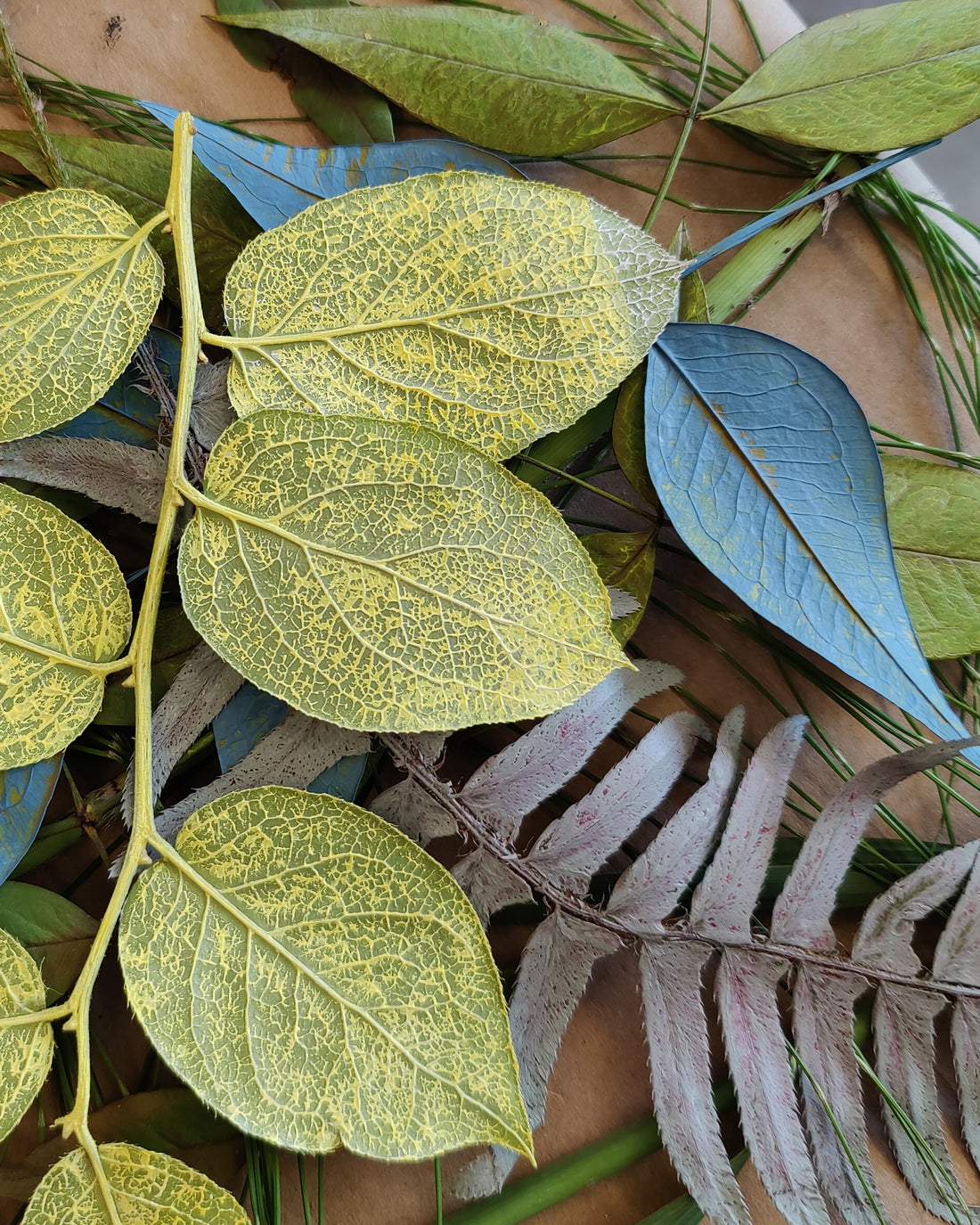
My Favorite Plants for Gel Plate Printmaking
It's finally Spring where I live (still plenty of rain and cold), and I'm starting to see leaves on trees and many weeds around my house. I started experimenting with botanical material on my gel plate a few years ago and use plants more and more during the warmer months while teaching botanical printing workshops.
The suggestions listed below are some of my favorite printing plants and are readily available near me. I've included photos of how I've used them in my artwork. You can also view some of my available botanical pieces here.
Some of these plants may not be available where you live, but hopefully, they provide an idea of the plant types that might create successful gelli prints in your neighborhood.
FERNS
Ferns are wonderful for gel printing! They are naturally flat and provide both an interesting silhouette print, as well as a fantastic texture print. I have a variety of ferns that grow in a shady spot in my yard. The Western Sword Ferns are tougher and work best when pressed first, they'll last a long time after pressing too. The Wood Ferns are very delicate, so I find it’s better to use them within hours of cutting before they get limp and start to curl under on the edges.
This piece used a Western Sword Fern for the silhouette, which I continued beyond the print with hand stitching.


HEAVENLY BAMBOO
I was fortunate to have this plant growing right next to my front door but didn't appreciate it till I started using it for gel printing. The branches have wonderful clusters of leaves that aren't packed together and are naturally quite flat, so they don't require pressing ahead of time. The leaves will start to curl under and become brittle after a few days but should last for a one or two printing sessions.
I used both the silhouette and the texture from the Heavenly Bamboo plant for a series of "Botanical Mashups" last summer.

SALAL
Some may be surprised by my inclusion of this plant on the list because they are definitely not flat. The combination of thin branches and rounder leaves on Salal creates some wonderful shapes for masking, especially if you're layering the silhouette on top of other plant prints. Since it isn't naturally flat, this is a plant that requires A LOT of pressing for successful prints. I usually cut a few short branches, stick them between the pages of a large book, and then stack a heavy paint can on top for a few days. They are another sturdy plant that will last a long time, even after a printing session or two.
The large round leaves of the Salal branch provide a lot of open space to view the layers underneath in these small monotypes.

These leaves look like art after a few printing sessions.

HORSETAILS
I got in trouble last year when I posted my first reel using a Horsetail. I didn't know what it was and called it an invasive "weed". A few plant enthusiasts corrected me in the comments. Turns out they've been around since prehistoric times in my area, but I still think most gardeners would consider them a nuisance as they are nearly impossible to eradicate. But that works well for me because they are abundant among the truly invasive Himalayan Blackberries in a wooded area near my home.
Horsetails look like something out of a Dr. Seuss book, or at least what I think Dr. Seuss would've created. When they are mature and taller, the "leaves" have more space and create more interesting prints. I love how wild they appear.

MAPLE LEAVES
I'm fortunate to have a few small leaf maple trees in my front yard. The beauty of these smaller leaves is that I have the option to clip off a branch with a few leaves and seeds to use as a larger silhouette or just pull the leaves off individually to scatter across my gel plate. Pressing the leaves/branches ahead of time isn't necessary, but I find that the branches in particular work better pressed and the leaves will last a long time once pressed, making them available for off-season gel printing.
This gel print used the texture and silhouette of some individual leaves. I added embroidery afterwards to fill the white space.

Here are a few branches I pressed last fall that are still in good shape.

GERBER DAISIES
I don't use flowers much, but one of my favorites to use for printmaking is a Gerber Daisy. It is sturdy, has a large head, and unlike the other plants listed above, I use these flowers as a stamp on my gel plate. One large impression in the middle of a square plate is fun, but it also works well to use the flower head to create a repeating pattern all over the plate.

Truthfully, I'll try any interesting plant on my gel plate at least once, as long as it doesn't have sharp points or thorns. I find it annoying to use dried herbs such as lavender, because the seeds stick to the plate and are a pain to pick off.
But, I love creating layers in my botanical work by combining gel prints of the silhouette and texture from different plants. Remember to try varying the sizes of the plants too (i.e. narrow stems of grass combined with larger round leaves.)
What plants are your favorites to print with? Happy Gel Printing!
And, if you're in the Seattle area join me for a Botanical Gel Printing Workshop this spring.
1 comment
Amei seu trabalho, muito bom gosto, representam bem as formas botânicas. Parabéns